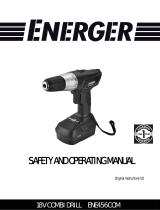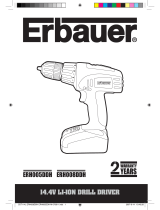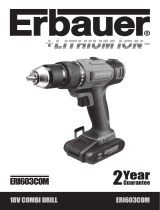
1.1. GENERAL SAFETY.
Disconnect the drill from the battery unit before changing accessories, servicing or performing any maintenance.
Maintain the drill and battery in good condition. Check moving parts alignment on a regular basis.
Replace or repair damaged parts. Use an authorised service agent and recommended parts only. Unauthorised parts may be
dangerous and will invalidate the warranty.
Ensure the drill is switched off before installing the battery pack.
Keep the drill and charger clean for best and safest performance.
Remove ill fitting clothing. Remove ties, watches, rings and other loose jewellery and contain long hair.
Evaluate your working area before using the drill e.g. ceilings, floors and enclosures may contain electrical items or water piping.
Ensure battery pack is correctly inserted into the drill handle and latched in place before attempting to switch on drill.
Secure loose work pieces with a clamp, vice or other adequate holding device.
Avoid unintentional starting.
Wear approved safety eye protection (standard spectacles are not adequate).
Maintain correct balance and footing. Ensure the floor is not slippery and wear non-skid shoes.
Be aware that this drill does not need to be plugged into the mains power.
Keep chuck direction switch in the locked position until the drill is required for use.
Keep children and unauthorised persons away from the working area.
DO NOT use the drill where there are flammable liquids, solids or gases, such as paint solvents, etc.
DO NOT allow children to operate the drill.
DO NOT operate the drill if any parts are missing as this may cause failure and/or personal injury.
DO NOT hold unsecured work piece in your hand.
DO NOT leave the drill operating unattended.
DO NOT carry the drill with your finger on the power switch. Keep chuck direction switch in the locked position.
DO NOT use the drill for a task it is not designed to perform.
DO NOT operate the drill when you are tired or under the influence of alcohol, drugs or intoxicating medication.
DO NOT get the drill or battery charger wet or use in damp or wet locations.
Keep drill and charger in the case and store in a safe, dry, childproof area where the temperature will not exceed 104°F (40°C).
1.2. BATTERY SAFETY.
WARNING! Battery contains nickel-cadmium which is dangerous. Handle with care to avoid damage, fire, corrosion or personal injury.
Charge battery prior to first use. The battery pack will have been shipped in a low charge state.
Use only the charger provided to charge the drill battery.
DO NOT charge battery when room temperature is below 50°F (10°C) or above 104°F (40°C).
DO NOT attempt recharging the battery by means of an engine generator or a DC power source.
DO NOT short-circuit the battery by linking both terminals with a metal object, or your fingers etc.
DO NOT store the battery (or drill) in locations where the temperature may exceed 104°F (40°C) such as outside sheds, above
heaters, or metal buildings in summer.
WARNING! Dispose of spent batteries correctly.
DANGER! DO NOT attempt to disassemble the battery pack. For safety and environmental reasons DO NOT discard in domestic
waste or by burning. ONLY discard or recycle according to local authority regulations.
WARNING! DO NOT allow a leaking battery to contact your person. If you come into contact with battery liquid take the following
immediate action:
a) Skin contact: Wash immediately with soap and water, then wash flesh in either lemon juice or vinegar.
b) Eye contact: Wash with a strong solution of boric acid, and seek immediate medical attention.
1.3. ELECTRICAL SAFETY.
WARNING! It is the owner’s responsibility to read, understand and comply with the following electrical instructions:
You must ensure the risk of electric shock is minimised by the installation of appropriate safety devices. An RCCB (Residual Current
Circuit Breaker) should be incorporated in the main distribution board. We also recommend that an RCD (Residual Current Device)
is used with all electrical products, particularly portable equipment which is plugged into an electrical supply not protected by an RCCB.
You must also read and understand the following instructions concerning electrical safety.
1.3.1. The Electricity At Work Act 1989 requires all portable electrical appliances, if used on business premises, to be tested by a qualified
electrician, using a Portable Appliance Tester (PAT), at least once a year.
1.3.2. The Health & Safety at Work Act 1974 makes owners of electrical appliances responsible for the safe condition of the appliance and
the safety of the appliance operator.
If in any doubt about electrical safety, contact a qualified electrician.
Ensure that the charger and cable are inspected for wear and damage, to ensure they are safe before connecting to the mains power
supply. If worn or damaged DO NOT use, immediately replace or contact a qualified electrician.
Check cables are always protected against short circuit and overload.
Important: Check that the voltage marked on the charger is the same as the power supply to be used.
DO NOT pull or carry the charger by the power lead, or pull the plug from the mains socket by the power lead.
DO NOT use any other type of charger.
DO NOT try to open or dissemble the charger.
DO NOT get the charger wet, or use in wet, damp conditions (for indoor use only).
1. SAFETY INSTRUCTIONS
INSTRUCTIONS FOR:
CORDLESS DRILL/DRIVER 14.4V
MODEL No: CP14035V
Thank you for purchasing a Sealey product. Manufactured to a high standard this product will, if used according to these instructions and
properly maintained, give you years of trouble free performance.
IMPORTANT: PLEASE READ THESE INSTRUCTIONS CAREFULLY. NOTE THE SAFE OPERATIONAL REQUIREMENTS, WARNINGS, AND
CAUTIONS. USE THIS PRODUCT CORRECTLY, AND WITH CARE FOR THE PURPOSE FOR WHICH IT IS INTENDED. FAILURE TO DO SO
MAY CAUSE DAMAGE AND/OR PERSONAL INJURY AND WILL INVALIDATE THE WARRANTY.
Original Language Version CP14035V Issue:4 - 12/01/12

IMPORTANT WARRANTY INFORMATION:
The battery pack fitted to this cordless tool is considered to be a consumable item and its ability to accept charge will reduce over
time. We will warranty it against mechanical and electrical defect for a period of one year - this does not cover fair wear and tear. If the
battery is not properly charged before first use, or regularly conditioned, its capacity will diminish. Under these circumstances we will
not replace the battery pack even if it is less than one year old.
3.1. CHARGING THE BATTERY PACK
3.1.1. To remove the battery pack from the drill, depress the two side clips on the battery. Do not touch the metal battery terminals.
3.1.2. Place the charger on a safe flat surface and connect to the mains.
3.1.3. The battery is designed to fit into the charger one way only. This is to ensure that the positive (+) and negative (-) polarities
correspond. Align the + and - polarity marks on the base of the battery with the + and - marks on the charger, insert the battery and
press lightly to seat the battery firmly into the charger (fig.1).
WARNING! DO NOT try to force battery into the charger with crossed
polarities.
3.1.4. When the battery is inserted the green LED will illuminate to indicate that
charging is taking place. The battery will take 3 to 5 hours to fully charge
(note: the green LED will stay illuminated and NOT extinguish when the
battery is fully charged).
Note: When new, the battery may have been shipped in a low charge state. It
will take longer to charge the battery initially and several subsequent
charges may also take a little longer, than when the battery reaches its
optimum performance.
3.1.5. Remove the battery from the charger. Unplug the charger from the mains.
Push the battery into the drill's base, until it latches into place. The drill is
now ready for use.
Note: If you need to recharge the battery immediately after use allow the
battery to cool before inserting it into the charger.
3.2. USING THE DRILL
(Ensure that you have read, understood and comply with all the
safety instructions in Section 1)
WARNING! Always wear approved safety glasses when drilling.
3.2.1. Ensure the direction switch is in the mid (lock) position. Open the chuck
by holding the rear collar and turning the front chuck collar (See fig.2).
3. OPERATING INSTRUCTIONS
2. INTRODUCTION & SPECIFICATION
1.4. BATTERY CHARGER SAFETY INSTRUCTIONS.
WARNING! DO NOT use the charger to charge any battery other than that supplied for the drill. Other types of batteries may explode!
All mains electrical supply safety features must be followed as described in 1.3. above.
Disconnect the charger from the mains power supply when not in use.
DO NOT operate the charger if it has been dropped, or has received a sharp knock, or is damaged. Contact an authorised service agent.
DO NOT insert foreign objects or material into the hole reserved for the battery.
DO NOT force the battery into the charger. The battery will only fit one way to ensure correct polarity alignment.
DO NOT immediately charge a second battery. Consecutive charging will overheat the charger. Allow the unit to cool for 15 minutes
before charging the next battery.
DO NOT attempt to connect two chargers together.
Store the charger in the same manner as the battery, see section 1.2.
Variable Speed: ................................0-550rpm
Chuck Size: ......................................10mm
Weight Including Battery: ...........................1.48kg
Battery Model No:............................CP14035VBP
Noise Power .....................................67dB.A
Noise Pressure...................................78dB.A
Drilling Capacities:
Wood: ...........................................10mm
Metal: ............................................6mm
Accessories: ...........................Magnetic Bit Holder
Drills:............................... 1.5, 2.5, 3, 4, 5, 6mm
Screwdriver Bits: ...Slotted 5, 6mm / Phillips #1, #2 / Pozi #1, #2
Superbly balanced tool, intended for professional use. Features twenty one position torque control. Electronic variable speed control with
reverse. 10mm keyless chuck. LCD display indicates battery level. Ideal for both screw driving and drilling. Supplied in carry-case together with
accessories.
fig.1
Original Language Version CP14035V Issue:4 - 12/01/12
Risk of Hand Arm Vibration Injury
Cordless Drill/Driver 14.4V model no. CP14035V when operated in accordance with these instructions and tested in accordance with
BS EN
28662-1:1993, ISO 8662-1:1988
and
BS EN ISO 8662-6:1995, ISO 8662-6:1994
results in the following vibration emission declared in
accordance with BS EN 12096:1996.
Measured vibration emission value: 0.969m/s² Uncertainty: 0.39m/s²
These values are suitable for comparison with emission levels of other tools that have been subject to the same test.
This tool may cause hand-arm vibration syndrome if its use is inadequately managed.
This is a ‘NO LOAD’ vibration figure.
A competent person should carry out a risk assessment following HSE guidelines.
Measurement results can be highly variable, depending on many factors, including the operator's technique, the condition of the work
equipment, the material being processed and the measurement method.
Recommended Measures to reduce risk of hand-arm vibration syndrome:
We recommend appropriate safety equipment is utilised and regular breaks for the operator are employed to reduce any residual risk of
fatigue or repetitive strain injury.

ENVIRONMENTAL PROTECTION
Recycle unwanted materials instead of disposing of them as waste. All tools, accessories and packaging should be
sorted, taken to a recycle centre and disposed of in a manner which is compatible with the environment.
When the product is no longer required, it must be disposed of in an environmentally protective way.
BATTERY REMOVAL
1. Remove the battery pack - see section 3.1.1.
2. Dispose of spent battery pack correctly.
ONLY dispose of or recycle according to local authority regulations.
Under the Waste Batteries and Accumulators Regulations 2009, Jack Sealey Ltd are required to inform potential
purchasersofproductscontainingbatteries(asdenedwithintheseregulations),thattheyareregisteredwithValpak’s
registered compliance scheme.
Jack Sealey Ltd’s Batteries Producer Registration Number (BPRN) is BPRN00705
NOTE: It is our policy to continually improve products and as such we reserve the right to alter data, specifications and component parts without prior notice.
IMPORTANT: No liability is accepted for incorrect use of this product.
WARRANTY: Guarantee is 12 months from purchase date, proof of which will be required for any claim.
INFORMATION: For a copy of our latest catalogue and promotions call us on 01284 757525 and leave your full name and address, including postcode.
01284 757500
01284 703534
sales@sealey.co.uk
Sole UK Distributor, Sealey Group,
Kempson Way, Suffolk Business
Park, Bury St. Edmunds, Suffolk,
IP32 7AR
www.sealey.co.uk
Web
email
Ni-Cd
Original Language Version CP14035V Issue:4 - 12/01/12
3.2.2. Insert the required drill or screwdriver bit fully into the chuck
and tighten chuck.
3.2.3. The speed of the drill is controlled by the variable power
trigger.
After moving the direction switch to ‘forward’ or ‘reverse’ as
appropriate, squeeze the power trigger gently for a slow
speed and progressively increase the pressure on the trigger
to produce correspondingly higher speeds.
3.2.4. To select torque or drill setting, twist the torque selector ring
to the required setting - from 1 (the lowest) to 21 (the highest)
for torque setting or to the drill symbol for drilling. (See fig.2).
3.2.5. Drilling.
Insert a pilot drill bit (a smaller sized drill than the required
finished hole size) into the chuck and lock in position. Check
to confirm the rotational direction is correct (DO NOT attempt
to change direction whilst the drill is running).
After drilling the inital pilot hole, insert the final sized drill bit
and drill out the hole to the appropriate size. If the drill
becomes stuck, release the trigger and place the drill in
reverse and try running the drill slowly whilst moving the drill
out of the hole. If this does not work, gently work the drill bit
free. If the chuck stops turning, check the torque setting.
3.2.6. To check the condition of the battery, press and hold the
battery indicator button next to the battery level indicator at
the rear of the drill.
3.2.7. When finished working, remove the bit from the chuck, clean
drill and bit, and store in the case.
fig.2
/






